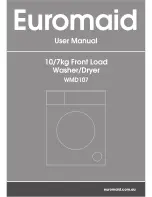
38
exhaust duct information
A longer exhaust duct than specified will:
• Increase the drying times and energy cost.
• Reduce the dryer life.
• Accumulate lint, creating a potential fire hazard.
exhaust length
RECOMMENDED MAXIMUM LENGTH
Exhaust hood types
Recommended
Only for short length
installations
No. of 90°
elbows
Rigid
metal
Flexible metal
Flexible metal
meters (m)
0
1
2
3
27,4 m
18,3 m
13,7 m
10,6 m
16,7 m
12,2 m
9,1 m
6,0 m
18,3 m
13,7 m
10,6 m
7,6 m
13,7 m
9,1 m
6,0 m
4,5 m
exhaust system checklist
exhaust hood or wall cap
• Terminate in a manner to prevent back drafts or entry
of birds or other wildlife.
• Termination should present minimal resistance to the
exhaust airflow and it should require little or no
maintenance to prevent clogging.
• Never install a screen in or over the exhaust duct.
• Wall caps must be installed at least 30.5 cm above
ground level or any other obstruction with the opening
pointed down.
• If roof vents or air distribution boxes are used, they must
be equivalent to a 10 cm wall cap with gate for air flow
resistance, prevention of back drafts and maintenance
required to prevent clogging.
INSULATION
•
JOINT SEALING
• All joints should be tight to avoid leaks. The male end of each section of duct must point away f rom the dryer.
• Do not ass emble the ductwork with fasteners that extend into the duct. They will serve as a collection point for lint.
• Duct joints can be made air and moisture tight by wrapping the overlapped joints with duct tape.
• Completely horizontal installations should slope down toward the exterior 12.7 mm (1/2 inch) per 30 cm (1ft)
ELBOWS OTHER THAN 90°
• One elbow of 45° or less can be ignored.
• Two 45° elbows should be treated as one 90° elbow.
• Any elbow of 45 ° or more should be treated as a 90° elbow.
ELBOW SEPARATION
exhaust connection
WARNING:
• This dryer must be exhausted to the outdoors.
• Use only rigid metal duct
• Do not terminate exhaust in a chimney, gas vent, under an enclosed floor, attic or in any other (concealed space)
of a building. The accumulated lint could create a fire hazard.
• Provide an access for inspection and cleaning of the exhaust system, especially at elbows and joints. The exhaust
system should be inspected and cleaned at least once a year.
• Never terminate the exhaust into a common duct with a kitchen exhaust system. A combination of grease and
lint creates a potential fire hazard.
• Do not obstruct incoming or exhausted air.
standard rear exhaust
warning: use only rigid metal 4" duct. do not install longer duct than
specified in the exhaust length table
The MAXIMUM ALLOWABLE duct length and number of bends of the exhaust system depends upon the type
of duct, number of elbows, the type of exhaust hood (wall cap), and all the conditions noted below. The
maximum duct length for rigid and flexible metal ducts is shown in the table below.
For best performance, separate all elbows (turns) by at least 1.2 m. (4ft.) of straight duct, including distance between last elbow
and exhaust hood.
Ductwork which runs through an unheated area or which is situated adjacent to an air conditioning duct should be insulated
to reduce condensation and lint accumulation.
WE STRONGLY RECOMMEND A RIGID METAL EXHAUST DUCT.
HOWEVER, IF FLEXIBLE DUCT IS USED CUT IT TO THE
APPROPIATE LENGTH AND AVOID STACKING THE DUCT
BEHIND THE DRYER.
The correct exhaust installation is your responsibility.
Problems related to to incorrect installation are not covered by
the warranty.
·
· WE RECOMMEND TO INSTALL YOUR DRYER BEFORE INSTALLING
YOUR WASHER THIS. WILL ALLOW EASIER ACCESS WHEN INSTALLING
DRYER EXHAUST.
THIS DRYER COMES READY FOR REAR EXHAUST. IF SPACE IS
LIMITED USE THE INSTRUCTIONS TO EXHAUST DIRECTLY FROM
THE LEFT SIDE OR BOTTOM OF THE CABINET.
52
















































